Knot tying is an essential skill offering countless applications in camping, sailing, and emergency situations. This guide provides clear, step-by-step instructions for mastering fundamental knots.
Why Knot Tying is Essential
Knot tying is a fundamental skill that ensures reliability and safety in various situations. Whether for camping, sailing, or rescue operations, a well-tied knot can prevent accidents and save lives. Its versatility makes it indispensable in both everyday tasks and critical emergencies. Learning knots fosters problem-solving skills and enhances confidence in handling ropes effectively. Proper knots distribute tension evenly, reducing the risk of failure under stress. They are also essential for securing loads, creating shelter, and navigating challenging environments. With the right techniques, anyone can master knots, making them a crucial tool for outdoor enthusiasts, professionals, and emergency responders alike. This guide provides a comprehensive approach to understanding their importance and application.
Brief History of Knot Tying
Brief History of Knot Tying
Knot tying has been an essential human skill since prehistoric times, with evidence of its use in ancient tools and shelters. Early civilizations relied on knots for sailing, fishing, and constructing structures. The art evolved through maritime exploration, where sailors developed secure knots for rigging and navigation. Over centuries, knot tying spread across industries, from climbing to rescue operations. The Ashley Book of Knots, a seminal work, cataloged hundreds of knots, making the craft accessible. Today, knots remain vital in outdoor activities, emergency response, and everyday tasks, showcasing their timeless utility and versatility across cultures and eras. This guide builds on this rich history, offering practical insights for modern applications.
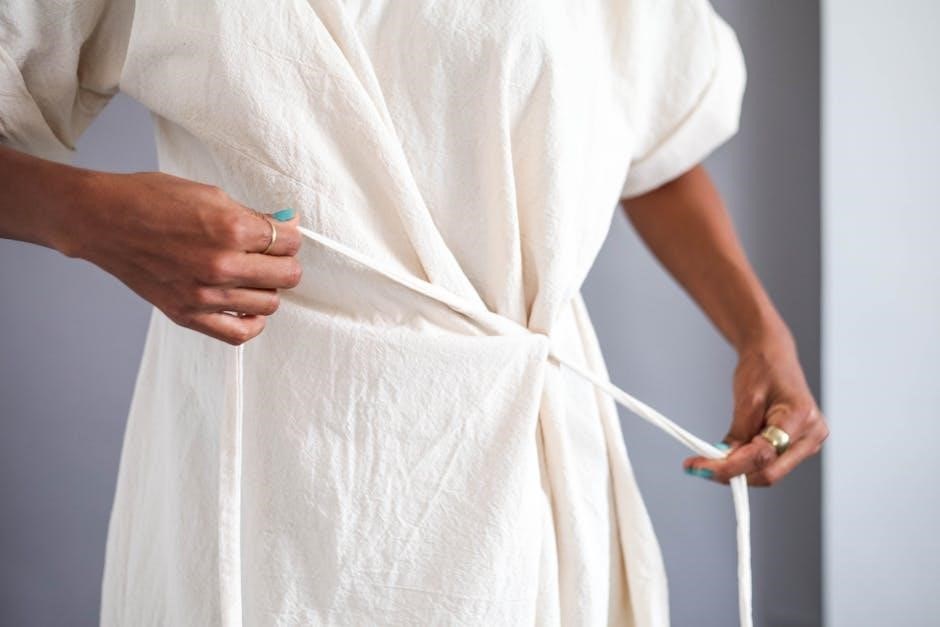
Types of Knots
Knots are categorized into loops, bends, hitches, and stops, each serving unique purposes. Common knots like the Bowline and Reef Knot are essential for secure and reliable fastening in various applications.
Loops, Bends, Hitches, and Stops
Knots are categorized into four primary types: loops, bends, hitches, and stops. Loops create a fixed or adjustable ring at the end of a rope, such as the Bowline. Bends join two ropes together, like the Square Knot. Hitches secure a rope to an object, with the Clove Hitch being a popular choice. Stops prevent a rope from running out, like the Figure Eight Knot. Each type addresses specific needs and ensures reliable fastening in various situations, making them indispensable in sailing, camping, and rescue operations.
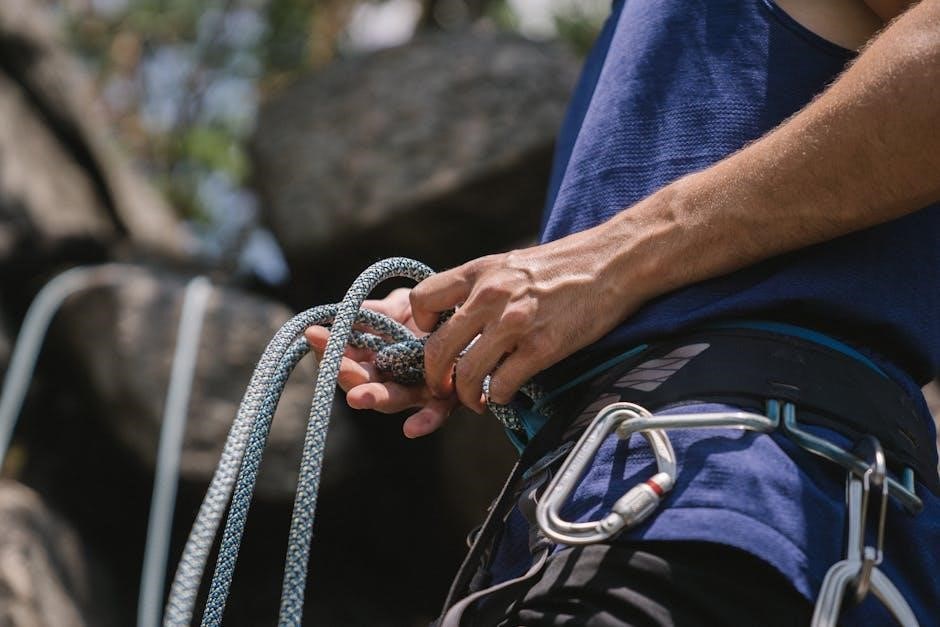
Popular Knots for Beginners
For those new to knot tying, starting with simple knots is essential. The Square Knot, ideal for joining two ends, is a foundational bend. The Clove Hitch, a versatile hitch, is easy to tie and adjust. The Bowline creates a secure loop and is perfect for sailing and rescue. The Figure Eight Knot acts as a stopper and is commonly used in climbing. These knots form the basis of more complex ties and are practical for everyday use. Mastering these early on builds confidence and skill, making them a must-learn for any beginner’s toolkit. They are versatile and applicable in many scenarios, ensuring a strong foundation in knot tying.
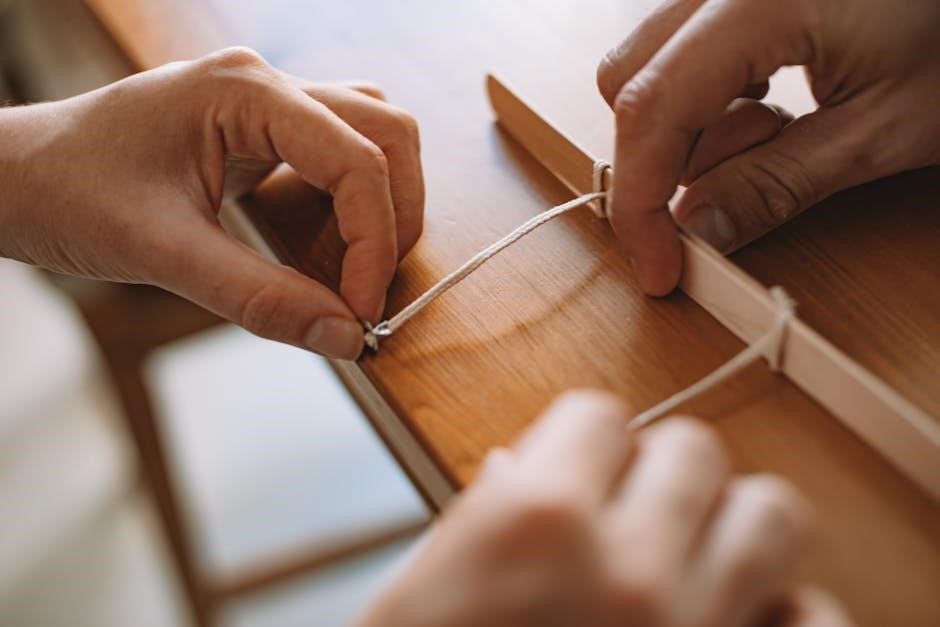
Safety Tips for Knot Tying
Always test knots before use and ensure proper rope selection. Avoid using knots like the Bowline in slippery materials for added security and reliability in critical situations.
Choosing the Right Rope
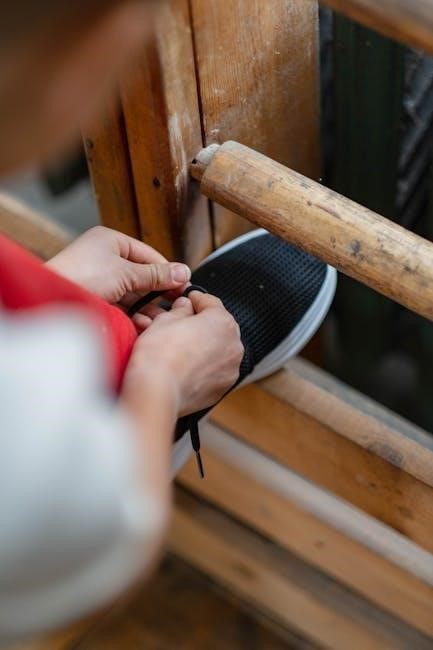
Selecting the appropriate rope is crucial for knot tying. Consider the material, diameter, and texture based on the task. Nylon and polyester ropes are durable and resistant to abrasion, while natural fibers like hemp are less common but still effective. Avoid using slippery materials like polypropylene for critical knots, as they can compromise security. The rope’s diameter should match the intended use—thicker ropes for heavy loads and thinner ones for precision tasks. Always test the rope for knots like the Bowline to ensure reliability. Proper rope selection enhances safety and ensures your knots perform as intended in various applications, from camping to rescue operations.
Common Mistakes to Avoid
Avoiding mistakes is key to mastering knot tying. One of the most frequent errors is improper tension, which can lead to knots coming undone. Ensure each knot is tightened evenly, especially for critical applications like climbing or sailing. Another mistake is using the wrong rope type, such as polypropylene for load-bearing knots, which can fail under stress. Additionally, neglecting to test knots before relying on them is a common oversight. Practice tying knots slowly and deliberately to build muscle memory. Regularly inspect ropes for wear and tear, as frayed or damaged ropes can weaken even the best-tied knots. By addressing these issues, you can improve the reliability and safety of your knots in various situations.
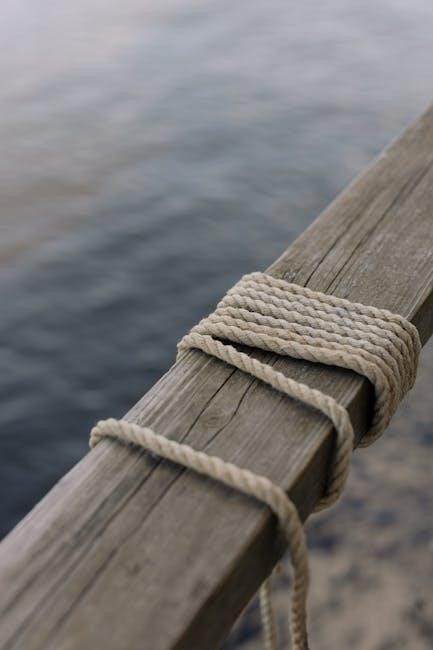
Visual Learning: Step-by-Step Guides
Step-by-step guides with photographs use color-coded ropes to clarify each knot’s structure, making learning intuitive and accessible for all skill levels.
Using Photographs for Clarity
Photographs are a powerful tool in understanding knot tying, offering visual cues that text alone cannot. Each step is captured in high detail, ensuring clarity. By using color-coded ropes, the process becomes even more intuitive. This visual approach helps learners track how strands interact and form the desired knot. For instance, seeing a Bowline’s loop form or a Reef Knot’s secure hold makes mastering these techniques easier. Photographs also highlight potential mistakes, allowing quick corrections. This method is particularly effective for beginners, as it bridges the gap between written instructions and practical application, making the learning process more engaging and effective.
Color-Coded Ropes for Better Understanding
Color-coded ropes significantly enhance the learning process by visually distinguishing different strands. This method simplifies complex knots, making each step more apparent. For example, using red and blue ropes side by side helps learners track loops and twists effortlessly. Such visual aids are particularly beneficial for beginners, as they reduce confusion and accelerate mastery. The color contrast highlights how knots form and interlock, ensuring a deeper understanding. This approach is widely recommended in educational materials, proving effective in both individual and group settings. By incorporating color-coded ropes, learners can focus on technique rather than deciphering intricate textual descriptions, making the entire process more intuitive and enjoyable.

Tools and Equipment
Essential tools for knot tying include a variety of ropes, cords, and practice boards. A complete knot-tying kit provides all necessary materials to master various knots effectively.
Knot Tying Kits
A comprehensive knot tying kit is designed to help beginners and experienced practitioners master various knots efficiently. These kits typically include high-quality ropes of different materials, such as nylon or polypropylene, and practice boards to aid in learning. Many kits also feature detailed instruction guides, either in print or digital format, with step-by-step diagrams and tutorials. Some advanced kits may include specialized tools like cordage or splicing aids. The best kits cater to diverse needs, offering everything from basic knots like the Bowline and Figure Eight to more complex ones used in sailing or rescue operations. Essential knots are often highlighted, ensuring users can practice and perfect the most useful ties for real-world applications.
Essential Tools for Practicing Knots
Practicing knots effectively requires the right tools to ensure clarity and ease. Color-coded ropes are highly recommended as they help distinguish strands, making it easier to follow step-by-step instructions. A sturdy practice board or post is also beneficial for securing ropes while tying knots. Additionally, a reliable knife or cutter is necessary for trimming excess rope material. Some kits include splicing tools to join ropes seamlessly, enhancing the overall learning experience. These tools, combined with detailed guides, provide a comprehensive setup for mastering various knots, from simple loops to complex hitches. Investing in quality tools ensures that each knot is tied securely and correctly, which is crucial for both safety and functionality.

Practical Applications
Knots are crucial in camping, sailing, and rescue operations. This guide provides practical advice for securing loads, creating loops, and ensuring safety in various scenarios.
Knots for Camping and Outdoor Activities
Camping and outdoor activities rely heavily on reliable knots to ensure safety and efficiency. The Bowline knot is ideal for setting up tent lines, creating secure loops for anchoring. The Sheet Bend knot excels at joining two ropes, perfect for extending tent guy lines or creating a longer rope for camp tasks. For securing loads, the Reef Knot is a go-to, while the Figure Eight knot is a must-know for climbing and rappelling. The Clove Hitch shines for securing gear to trees or poles, and the Taut-Line Hitch allows for easy adjustment of tent lines. Using color-coded ropes enhances learning, making it easier to master these essential outdoor knots.
Knots for Sailing and Boating
Sailing and boating require a strong foundation in knot tying to ensure safety and control on the water. The Bowline knot is indispensable for creating a secure loop at the end of a rope, ideal for docking or hoisting sails. The Reef Knot is commonly used to tie up a boat to a dock, while the Clove Hitch is perfect for securing fenders or temporary lines. The Rolling Hitch is essential for towing another boat or securing a rope to a post. Additionally, the Figure Eight knot prevents the end of a rope from fraying, making it a practical choice for sailing applications. Using color-coded ropes in guides enhances clarity, helping sailors master these critical knots efficiently.
Knots for Rescue and Emergency Situations
Knots play a crucial role in rescue and emergency operations, requiring reliability and speed. The Figure Eight Knot is often used to prevent rope ends from fraying, while the Bowline Knot creates a secure loop, essential for lifting or securing individuals. The Sheet Bend is ideal for joining two ropes, even if they differ in thickness, making it perfect for extending rescue lines. The Clove Hitch is used to secure ropes to posts or rails, providing quick adjustments. In emergencies, the Alpine Butterfly Knot is used for joining ropes in the middle, enabling efficient rescue operations. Using color-coded ropes in guides ensures clarity, helping responders master these life-saving knots swiftly and effectively. Proper knot tying is vital to ensure safety and efficiency in critical situations.

Troubleshooting Common Issues
Knots may fail due to improper tying or unsuitable rope types. Using a Figure Eight Knot prevents fraying, while avoiding polypropylene for Bowline Knots ensures reliability.
Why Knots Fail and How to Fix Them
Knots fail primarily due to improper tying, incorrect rope selection, or lack of maintenance. For example, a Bowline Knot tied in polypropylene rope can slip under stress. To fix this, use ropes with better grip. The Reef Knot, often used incorrectly as a bend, should never join two ropes under load. Instead, opt for the Figure Eight Knot for such applications. Regular inspection of knots is crucial, especially in critical situations like sailing or rescue operations. Ensuring the rope is free from damage and the knot is tightly secured prevents failures. Proper practice and understanding the right knots for specific tasks are key to reliability and safety.
Resources for Further Learning
Explore recommended books like Ashleys Knots and online forums for detailed guides. These resources offer in-depth knowledge and interactive learning for mastering knot tying skills effectively.
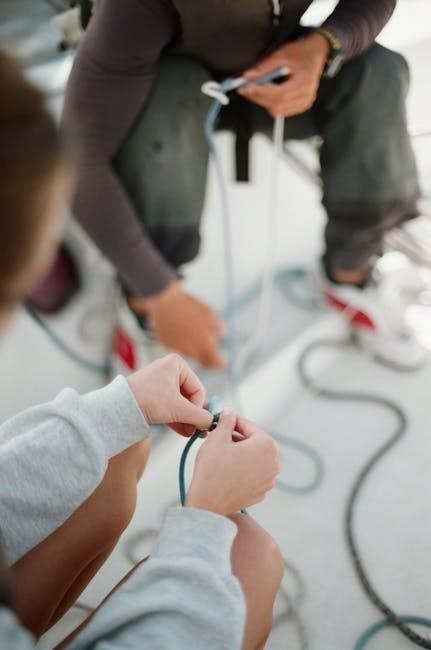
Recommended Books and PDF Guides
Ashley’s Book of Knots is a comprehensive encyclopedia detailing over 3,900 knots, making it a must-have for enthusiasts. For digital learners, downloadable PDF guides provide step-by-step visuals and clear instructions, perfect for on-the-go practice. These resources cover essential knots for camping, sailing, and rescue scenarios, ensuring you’re well-prepared for various situations. Whether you’re a beginner or an expert, these books and guides offer valuable insights and practical applications to enhance your knot-tying skills. They are indispensable tools for anyone looking to master the art of knot tying efficiently and effectively.
Online Communities and Forums
Online communities and forums dedicated to knot tying are invaluable resources for learners. Platforms like Reddit’s r/knots and specialized sailing forums offer spaces to ask questions, share techniques, and learn from experts. Many users post detailed guides, including PDFs, to help others master specific knots. These communities often feature step-by-step photographs and videos, enhancing understanding. Members frequently discuss common mistakes and provide troubleshooting tips, ensuring safer and more effective knot tying. Additionally, these forums foster collaboration, allowing enthusiasts to discover new knots and refine their skills. Engaging with these online groups can significantly accelerate your learning journey and connect you with a passionate community of knot tying enthusiasts worldwide.
Mastering knot tying requires patience and practice. Use visual guides with color-coded ropes for clarity and consult resources like PDFs for detailed instructions. Always test knots under load for safety and reliability, ensuring they hold securely in various conditions. By following step-by-step guides and avoiding common mistakes, you can confidently apply your skills in camping, sailing, and emergency situations. Troubleshoot issues promptly, and consider joining online communities for further learning and troubleshooting tips. Remember, the key to proficiency is consistent practice and understanding the mechanics behind each knot.
Mastering Knot Tying: Final Tips
Consistency is key to mastering knot tying. Practice regularly to build muscle memory and ensure reliability. Use visual aids like color-coded ropes for clarity. Troubleshoot issues promptly by understanding why knots fail. Refer to detailed guides and online communities for additional insights. Always test knots under load to confirm their security. Embrace patience, as proficiency takes time. Apply these skills in real-world scenarios to reinforce learning. By combining practice, troubleshooting, and practical application, you’ll become adept at tying knots for various purposes, from camping to emergency situations. Remember, mastery is a journey—stay persistent and confident in your abilities.
